Squeaking Noise While Driving But Not Brakes Applied: 11 Causes
Those squeaks and squeals coming from your car likely point to worn parts needing some gentle care. Suspension components—struts, sway bar links, bushings—take a beating. As they loosen, you’ll hear squeaking when turning or over bumps. Steering systems may squeak when turning if the steering pump is failing or steering column needs lubrication. Worn CV joints on front-wheel drives will squeak when cornering or accelerating. And pay attention to squeaking only when braking—that’s the brake pad’s wear indicator rubbing the rotor. Catch issues early by tuning your ears to common squeaking sources.
That annoying squeak coming from your car when you drive can be maddening, even when you’re not braking. The squealing may be intermittent or constant—either way, it’s not a pleasing sound.
More importantly, such a squeak could signal developing problems under the hood that may lead to costly repairs down the road.
So let’s break this down to understand what causes that irksome noise when simply driving, sans brakes. We’ll also explore solutions to silence the squeak for good before a minor issue snowballs into a major expense.
Some people also experience groaning noise when reversing their vehicles. So, be sure to check out my guide on that topic as well.
In this guide, I will also explain some brakes related issues that cause squeaking noise from cars even without braking.
For this, you have to first have an overview of working of disc brakes. If you don’t understand each part of the disc brake, it will be difficult for you to understand some technical terms I will be using in this guide. If you already have knowledge, you can jump straight to the causes section.
For you, I’ve made an interactive tool that helps identify car issues. It provides simple steps for diagnosis. Ensure to check it out.
- Worn brake pads with metal wear tabs rubbing against the rotor as an audible warning sign to replace pads.
- Stuck brake caliper pins preventing full pad retraction from the rotor.
- Warped brake rotors causing uneven pad contact and vibration.
- Stones stuck in tire treads creating friction and squeaking noise.
- Dry brake pad retaining clips in the caliper bracket causing pad vibration.
- Uneven tire inflation or wear leading to vibration and uneven road contact.
- Worn suspension components like ball joints rubbing and squeaking.
- Damaged CV joint boots allowing dirt inside, causing sticking and squeaking when turning.
- Loose or damaged serpentine belt/pulleys causing belt slippage and squeaking.
- Dry steering column joints needing lubrication and causing metal-on-metal squeaking.
Sometimes, brakes also squeak when you first start driving in the morning. If you experience, do check my guide on that.
What Are the Causes Of Squeaking Noise While Driving Without Applying Brakes?
Here are the causes of squeaking or squealing noises in car when driving:
1. Wear Indicator Of Brake Pads Touching Rotor
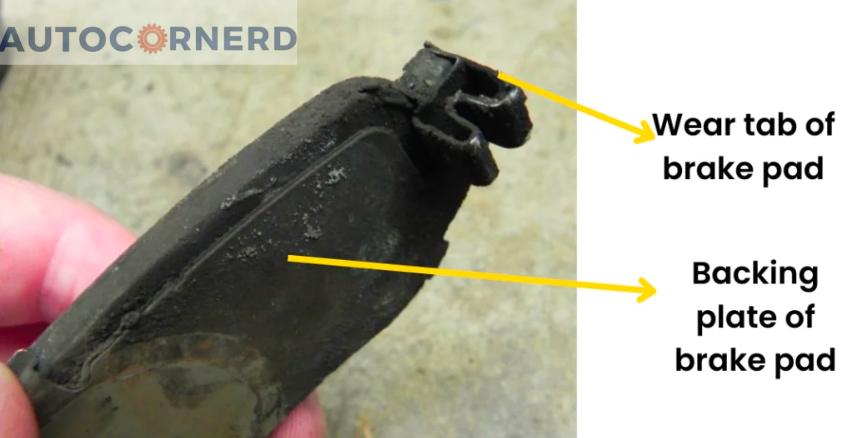
Brake pads have little metal bits called wear indicators attached to them. These tabs make a squeaky noise when the brake pads get too worn down. That squeak is telling you it’s time to replace your brake pads.
When the brake pads are still thick, the metal tabs don’t touch the brake rotor so there’s no noise. But as the pads wear away with use, the tabs start to rub against the rotor. This creates that squeaking sound. It’s done on purpose as a signal that your brake pads are too thin now.
You’ll see these wear indicator tabs on the sides or fronts of brake pads.
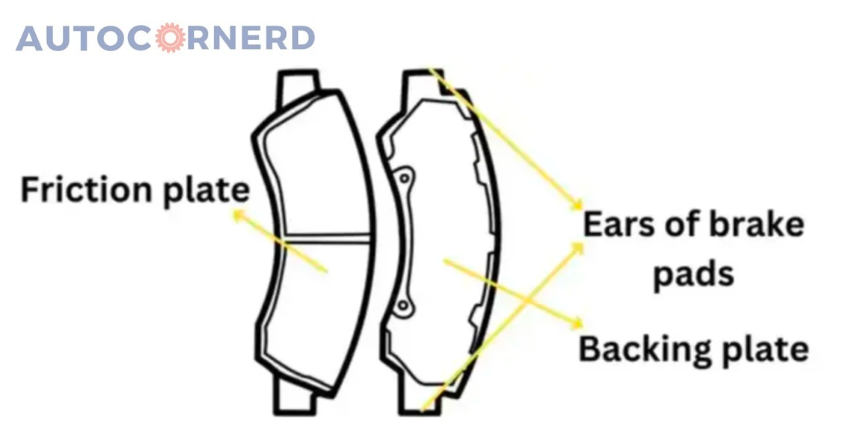
When you hit the brakes hard, you smash the brake pads tight to the rotor. That can temporarily stop the squeak by pushing those metal tabs back off the rotor surface. But soon as you ease off the brakes, the noise comes back if those pads are still too worn.
How to Fix?
Worn brake pads with scratched wear indicators drag and grind against the rotor, causing that awful squeaking noise. Ignoring these warning signs can lead to serious safety issues. As brake pads wear thin, braking power fades away, leading to longer stopping distances. In extreme cases, brakes can fail completely.
Safety first. Stick with original manufacturer parts (OEM) when replacing brake pads. OEM pads fit right and align properly, ensuring optimal braking performance.
Some aftermarket brake pads can have sizing or alignment issues that compromise safety. Why take a chance? OEM brake pads not only eliminate the annoying squeaks but, more importantly, restore safe braking.
Listen to the sounds your car makes – it’s a form of preventive maintenance that saves money and gives you peace of mind.
Using an inadequately sized brake pad can cause issues such as the vibration of the pad and uneven contact with the brake disc.
2. Sticking Brake Caliper Pin Making Squeaking Noises
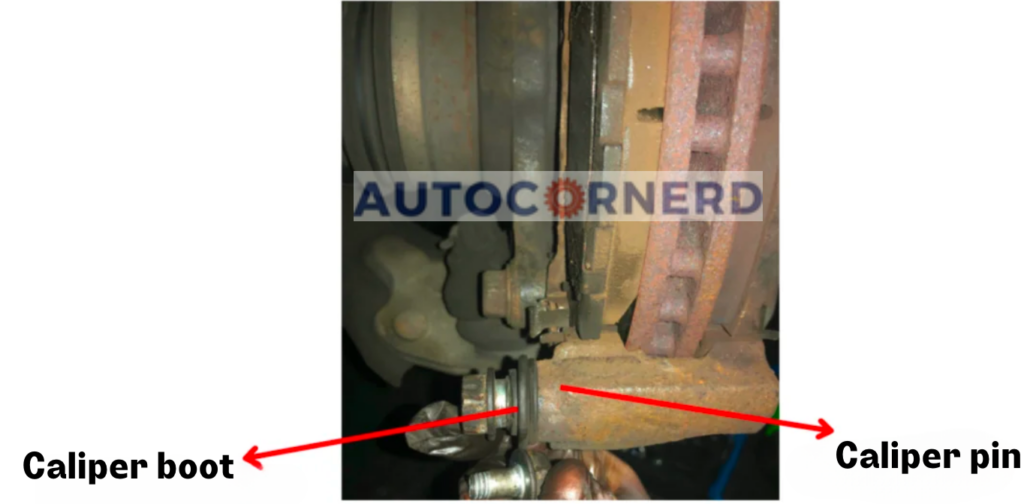
The caliper pin is a little component that connects the brake caliper to the brake pads. It lets the caliper squeeze those pads against the rotor when you hit the brakes. That friction between the pads and rotor is what slows your car down.
That tiny caliper pin also makes sure the caliper can wiggle around properly. That way, your brake pads wear nice and even.
There’s a little rubber boot on the caliper pin too. It keeps gunk out and grease in. No dirt or rust allowed! That helps everything move smooth as butter. But after some years of brake use, trouble can start brewing. Muck and rust might sneak past that little rubber boot. Then your caliper pin can get stuck, not wanting to budge one bit.
If your caliper pin sticks, it can leave the brake pad rubbing on the rotor even when you’re not braking. Then you get squeaky squeak squeaks.
It can also make your brake pads wear uneven. Then your brakes might not work as well. Or your car could shake when you brake. Or it might pull to one side.
How to fix?
Use a brake cleaner and a wire brush to clean any debris or rust off the pin. Also, get the debris and dirt out of the hole in which the caliper pin is inserted. You can use this brush to clean the bore of the caliper in which the pin slides.
Dip a bore brush or a cotton swab in the cleaning solution and gently clean the inside of the hole. Then apply a high-temperature brake lubricant to help it move freely. I would recommend this one.
Note: Excessive lubrication can trap air at the tip of the slide pin, causing the caliper/pad assembly to drag on the rotor. As such, always ensure that you use the correct amount of lubricant when applying it to the slide pins.
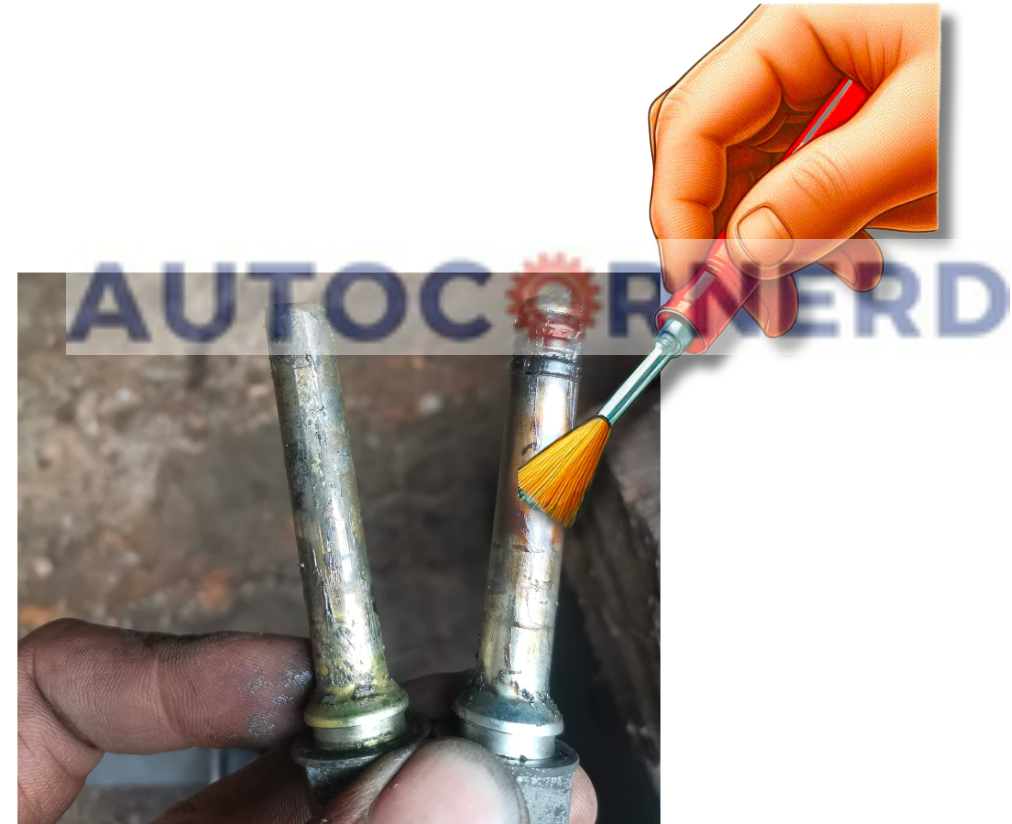
3. Warped and Uneven Rotor Surface Contact
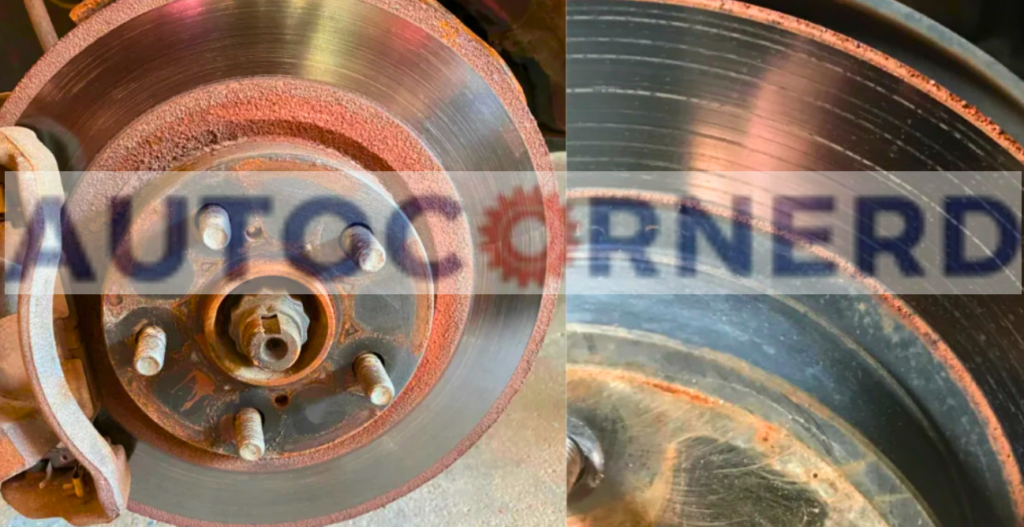
When rotors get a glazy film or have grooves cut into them, there’s no more smooth clamping surface for the brake pads.
The brake pads start skipping and slip-sliding instead of grabbing hold. That back and forth rub makes a squeal you’ll hear when your foot’s off the pedal.
But step on those brakes and all gets quiet. The pressure keeps things mashed together tight so the squeaks get muffled.
So What Makes Warped Rotors Squeak?
Rotors warp when they lose their flatness. Could be they got too hot or took a hit. These sad rotors end up with humps and curves instead of a nice smooth face.
Now when you brake, the brake pads smack into the rotor instead of meeting it evenly. This causes vibration in brake pads which results in a squeak you’ll hear even at low speeds like parking lots.
How to spot?
When the brake rotor becomes warped, it can become glazed or grooved. Glazing occurs when the brake pads become overheated and create a layer of shiny, hardened material on the surface of the rotor.
Grooving occurs when debris such as sand or dirt becomes embedded in the brake rotor and creates deep scratches.
We can’t visually observe warped brake rotors as the deformity caused by heat is usually very small. A couple of thousandths of an inch can cause the rotor to warp, which is too small to notice by simply looking at the rotors.
4. Small Rocks In Tire Tread
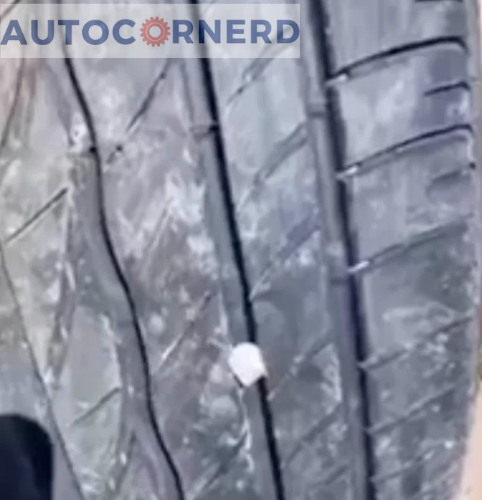
You know those grooves on your tires? Those are called the treads. They play a big role in keeping your car safely on the road, especially when things get wet or slippery.
The treads create channels that push water out from under the tires. This helps the rubber really grip the road so you don’t go slipping all over the place!
The treads also give your tires something to bite into when you’re driving on snow, mud, gravel, and other messy stuff.
Now sometimes while driving, little rocks or pieces of debris can get stuck in those tire treads. When that happens, it can make an annoying high-pitched squeaking or whining noise.
Here’s why: The trapped pebble starts vibrating like crazy as the tire goes around and around. It’s rubbing on the tire in a bad way. That friction is what makes the squeak!
Sometimes stomping on the brakes will knock that little rock free and presto! No more squeak. But not always. Sometimes the squeak hangs on even with the brakes applied.
How to fix?
If you do find stones stuck in your tires, you can pry the stones out of the tire treads using a tool such as a flathead screwdriver.
As your tire rolls over the road, any stones caught in the treads get pushed in deeper and deeper. This is called “stone drilling” – the stones drill right into the tire! Eventually they poke through the rubber and puncture the inside layers. It’s best to remove stones from your tires as soon as you can. Take a minute to check the tread grooves and dislodge any rocks or pebbles hiding there. Your tires will thank you! Driving with punctured treads can lead to dangerous blowouts or flats down the road.
If a stone penetrates into one or more of the treads, the tire might not be able to be repaired safely. The puncture can cause a weakening of the structure of the tire, and the tire might blow out while driving.
5. Brake Pads Not Retracting Fully
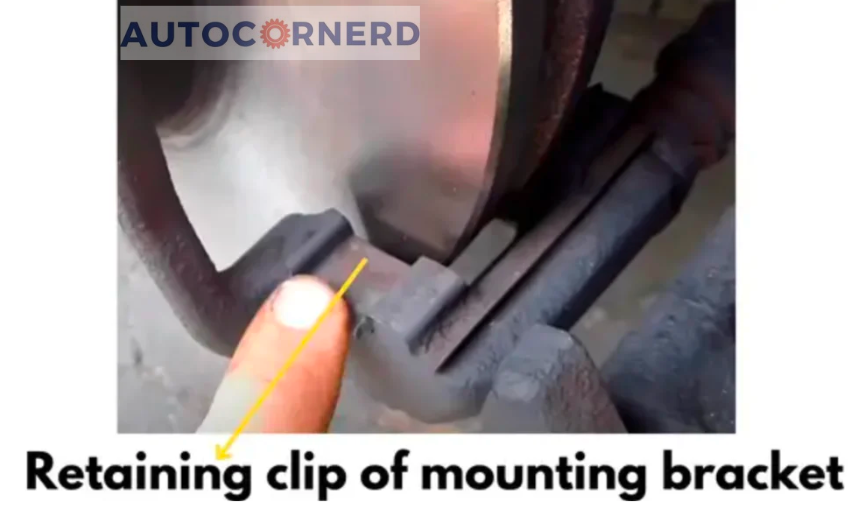
The brake pads can stay touching the brake rotor even after you take your foot off the brake pedal. This squeaking noise happens for a couple reasons.
One reason is a sticking brake caliper, which I already explained.
Another reason is that the brake pads need some lubrication where they fit into the caliper bracket.
Inside the caliper, there are small metal clips called retaining clips. These clips hold the brake pads in place, but let them slide smoothly when you press and release the brake pedal.
If the retaining clips don’t get lubricated, they can get dry and start wearing out. Then the brake pads end up vibrating against the rotor instead of sliding smoothly. That vibration makes the annoying high-pitched squeaking sound.
To summarize: Sticking calipers or dry, unlubricated retaining clips can both cause brake pad squeaking. The clips hold the pads in place but need to stay lubricated so the pads can slide off the rotor. Squeaking means the pads are vibrating instead of sliding smoothly.
How to fix?
To fix this, you need to remove the brake pads from the caliper bracket and lubricate the ears of the brake pads.
I would recommend ATE Plastilube Grease. Make sure you don’t apply grease to the friction plate of the brake pad as it will damage the material and brake rotor.
6. Tire Pressure Differences Cause Squeaking Noises
Keeping your tires inflated properly is really important for safe driving and making your car run well.
Tires that don’t have enough air can make your car harder to control, waste gas, and be more likely to fail on you. Over-inflating tires will give you a bumpy ride, less traction, and cause the tread in the middle of the tire to wear away quicker.
To keep your tires working their best, just follow the recommended pressure levels in your owner’s manual.
If the pressures get too uneven, it can wear down your tires in a choppy, scalloped pattern. It can also start making them squeak when you drive! One driver even said they got flat spots on their tire when it started squeaking.
Really uneven pressures across your tires can also make them vibrate and rub more on the road, so you hear squeaking while driving.
And if it gets really bad in just one tire, your car can start pulling hard to that side. That extra strain can further damage the tire and make even more noise.
A user even reported flat spots on their car’s tire when it started squeaking.
How to spot?
Here is how a tire looks with underinflation and overinflation:
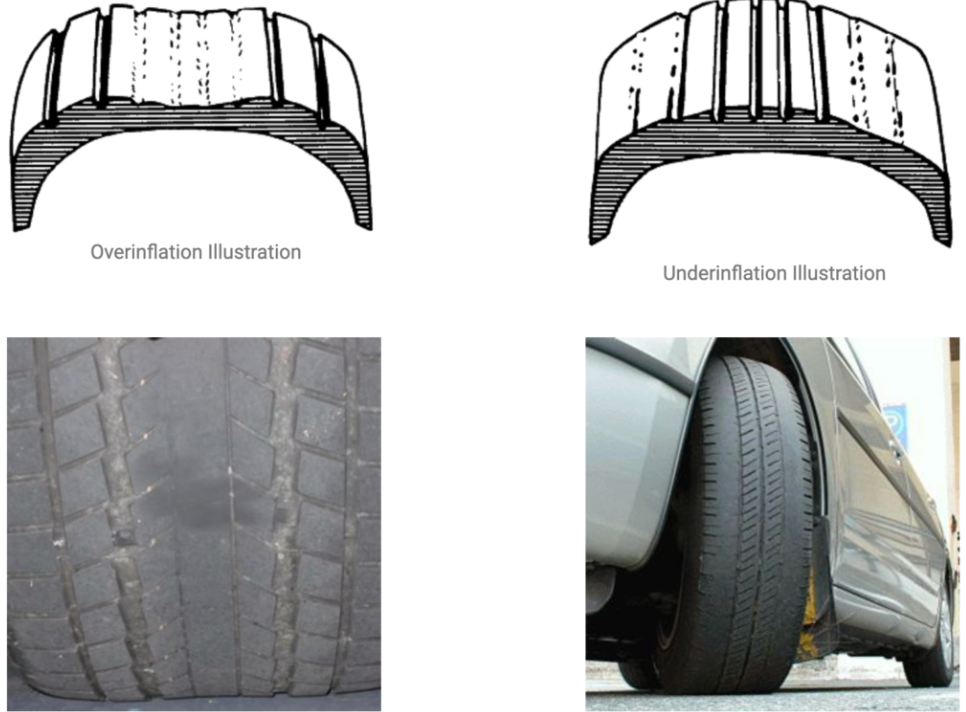
Source: https://www.autocornerd.com/ford-f150-humming-noise-while-driving/
How to fix?
You should inflate your car’s tires with recommended air pressure.
When you open the driver-side door of your car, you’ll see the label of recommended pressure for front and rear tires.
I have a 2018 Toyota Vitz. So, I have attached the picture of recommended tire pressure so that you can get an idea of how it looks:

In the picture above, 165/70/R14 is a tire size. 2.5 bar is the tire pressure for the front tires and 2.4 bar is the tire pressure for the rear tires.
7. Uneven Tire Tread Wear
When the tires on your car wear out at different rates, it’s called uneven tire wear. There are a few reasons this can happen:
- The tires are inflated improperly
- The wheels aren’t balanced
- The wheels are misaligned
- Your driving habits
Areas of the tire tread wear down more than others with uneven wear. This makes the rubber harder and less bendy. Now the tires slip around instead of gripping the road. You might hear a squeaking noise as they move on the pavement.
Some folks say uneven tire wear makes the tires lose their round shape.
The oddly shaped tire touches the ground at weird angles. More friction and noise trying to grip the road happens.
Vibrations through the whole car can occur too, causing squeaking even with no brakes.
How to prevent it?
The tried and true tip is to get new tires when the tread hits 2/32 inch. That depth meets legal minimums in some states. We say to aim higher at 4/32 inch. That extra tread keeps control and traction sound.
Saving tires from uneven wear isn’t too tough. Follow these straightforward steps:
- Air check. Keep tire pressure at recommended levels. That distributes vehicle weight evenly on all four.
- Spin rotation. Every 6K-8K miles, swap front tires back and back tires up. This keeps wear in line.
- Wheel checkup. Misaligned wheels drag tires down. Have a pro check and align as needed.
- Drive nice. No sharp turns, sudden stops, mean starts or potholes. Tires will thank you.
8. Worn Suspension Parts Can Squeak When Turning
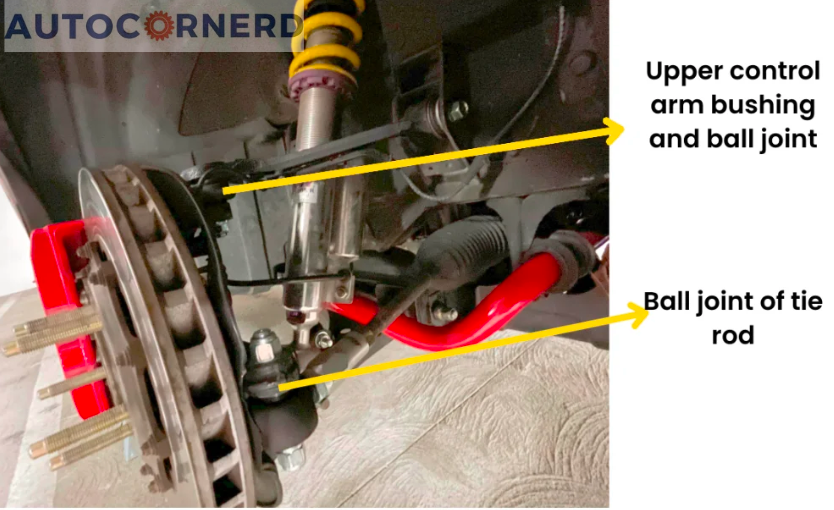
The parts that connect your car’s frame to the wheels are called suspension parts. These parts make sure your drive feels smooth and comfy. They include ball joints, control arms, struts, shocks, sway bars, bushings, tie rods, and other pieces.
When these parts get old and worn out, they can start rubbing on each other. This makes squeaky noises when you drive. The noises get worse when you go over bumps or turn corners. That’s because the parts move around more then.
Ball joints are very important suspension parts. They connect the steering knuckle to the control arm and tie rods. This allows the suspension to move and turn right while keeping the wheels lined up.
But when ball joints get too worn out, they can’t give enough support. Then the suspension gets loose and makes noise while driving. You can find ball joints where the tie rods and control arms connect.
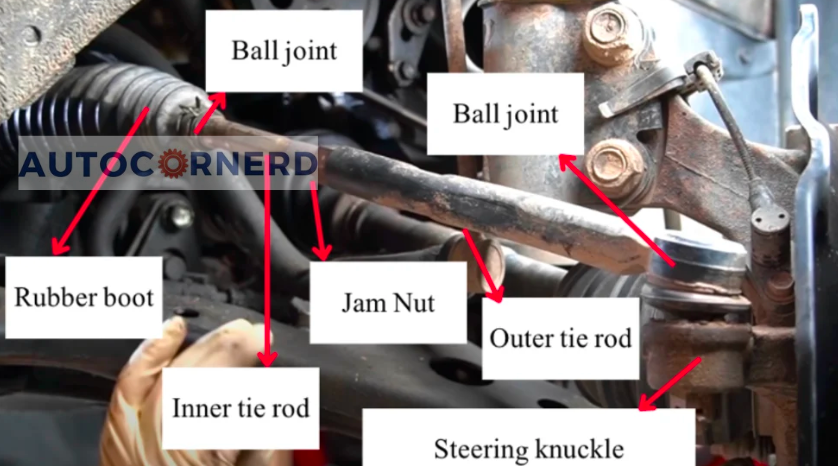
The control arms connect the wheel to the frame. They hold up the suspension so it can move right.
Old control arms get loose. Then the suspension gets loose too. It makes squeaking noise when you drive.
The rubber boots between parts also stop noise. These boot things are bushings. Old bushings make bad sounds while driving.
Springs and struts go bad sometimes too. They all squeak when worn out.
Bushings are also rubber boots providing a cushion between the suspension components and the vehicle’s frame, preventing metal-to-metal contact and reducing noise. Bushings can also wear out and cause squeaking noise while driving.
You will observe bushings in the connections of tie rod, control arms and sway bars. These bushings are around the ball joints.
How to fix?
In some cases, the worn-out components may need to be replaced entirely, while in others, they may simply need to be lubricated or adjusted by replacing the bushing around the ball joint.
To lubricate worn-out ball joints, you can use a grease gun to add grease between the ball and socket. This can be done by forcing the grease in under pressure via a nipple or by using a needle to carefully lift the boot and add grease to the joint.
You can also poke the needle into the boot of the ball joint to fill the grease but make sure to seal the little pinhole with tire patch gel or glue. You can use this grease gun with this grease injecting needle.
9. Failing CV Joints Causing Popping Sound
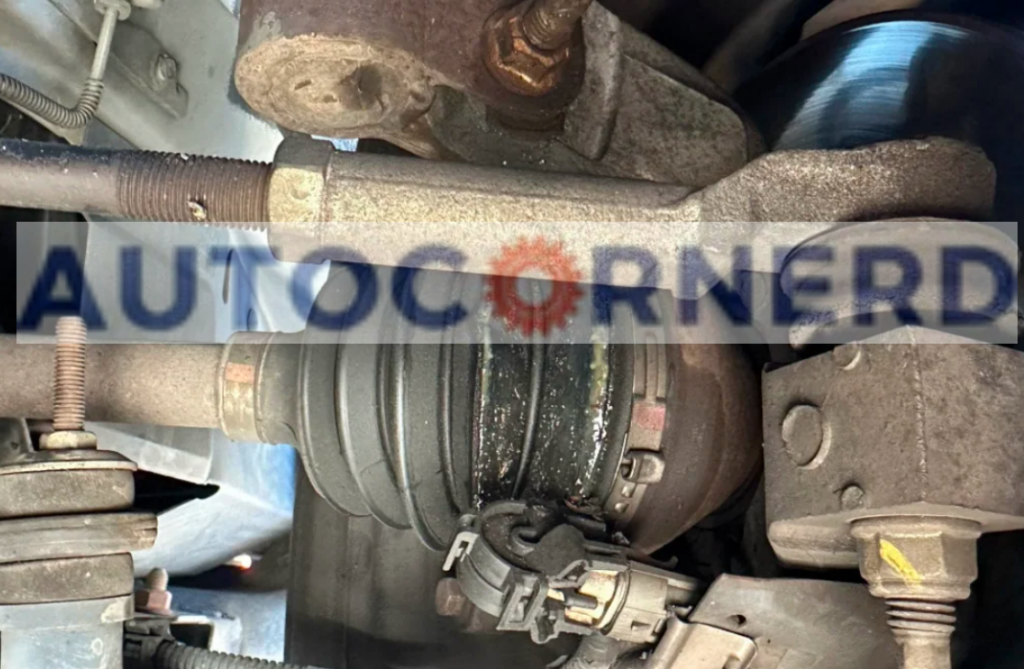
The inner and outer CV joints are essential parts of a front-wheel drive vehicle’s drivetrain. They let the axle smoothly go up and down as the wheels turn. This keeps the tires in contact with the road.
The inner CV joints connect the transmission and axle shafts. The outer CV joints connect the axle shafts to the wheels. Both types of CV joints are critical for the drivetrain to work right.
When a CV joint starts wearing out, it can’t move smoothly anymore. Instead, it may start sticking when you turn the steering wheel. This can make noises like:
- Squeaking
- Popping
- Clicking
You’ll notice these noises most when turning. The CV joint is under more stress then.
To learn more about how CV joints affect the transmission, check my guide.
How to fix?
You need to check if the rubber boot of the CV joint is damaged. The rubber boot encloses grease and bearing and protects the bearing from dirt and debris.
If you see the grease leaking behind the wheels of your car, the chances are that the CV joint boot is cracked. Other chances are that the bearing inside the rubber boot is damaged.
10. Bad Serpentine Belt Tensioner Bearing Can Squeal
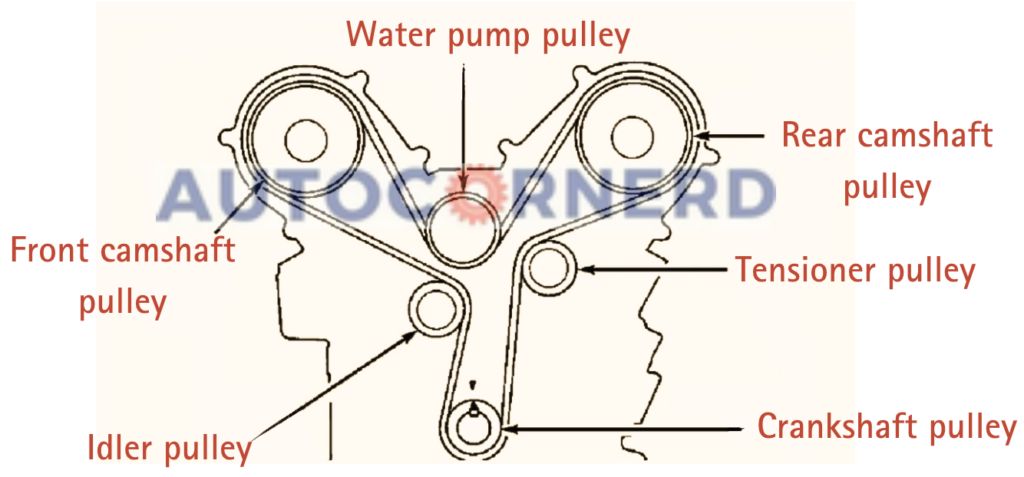
A vehicle has a long belt called the serpentine belt. This belt gives power to many parts of the engine, like the steering pump, AC compressor, and alternator.
The wheel that turns the belt is named the pulley. Pulleys have a grooved rim that the serpentine belt wraps around. Pulleys drive the belt to give power to engine parts.
The serpentine belt also goes around special pulleys called the tensioner pulley and idler pulley.
The tensioner pulley can pivot and has a spring inside. It keeps the belt tight so it does not slip or squeak. This helps the belt and engine parts last longer.
The idler pulley guides the belt around all the engine parts it powers. It keeps the belt lined up right so it does not fall off.
Over time, the pulley bearings can wear out. Then the pulleys become loose and wobbly.
When this happens, the pulleys will no longer be able to maintain the proper tension on the serpentine belt, which can cause it to slip and create that annoying squeaking noise.
How to spot?
Here are the signs that your serpentine belt or pulley is worn out and needs to be replaced:
- Cracks or fraying on the belt
- Broken or missing ribs on the belt
- Belt slipping or coming off the pulley
- Visually inspect the pulley for signs of wear, such as cracks, chips, or grooves. The pulley should also turn freely without any binding or wobbling
- Tensioner pulley is kicking a lot from side to side and ticking marks on the pulley
Moreover, the idler pulley should be tight. If the idler pulley has any play, it will cause the serpentine belt to become loose.
You can also use a stethoscope or a very long screwdriver to pinpoint where the noise is coming from.
11. Steering System Needs Lubrication
The steering pump has an important job in your vehicle’s steering system. When you turn the steering wheel, the pump sends fluid to the steering gear. This fluid makes turning the wheels much easier.
The pump has to create high pressure for this system. Without the steering pump, the steering wheel would be very hard to turn.
The steering column connects the wheel to the gears that turn the wheels. The column has a shaft, bushings, and joints. These let the wheel turn smoothly. If the steering column parts get dry or worn out, they can squeak when turning. The parts rub together without lubrication. This friction and metal-on-metal contact creates the noise.
If the squeak comes from the steering system, check the pump pulley. This spinning part can cause noise if worn out.
Final Thoughts
Squeaking noises emanating from your vehicle can indicate multiple issues, from worn brake pads to failing suspension parts. Remaining attentive to these auditory cues provides valuable insight into your car’s health.
Much like how coughing hints at respiratory troubles in humans, squeaks point to problems brewing under the hood or chassis. Ignoring them risks accelerating wear and tear.
Regular upkeep allows early identification and remedy, forestalling extensive repairs down the road. Routine tire rotation or balancing may pinpoint the origin, while lubricating hinges alleviates friction.
Although seemingly trivial, deciphering and resolving squeaks via prompt maintenance safeguards mechanical integrity. Your vehicle will glide down smooth highways rather than creak over potholed streets.
Some First Hand Experiences Shared By Users In Different Communities
Our team conducted research across various online communities, forums, and subreddits to gather user comments and opinions on “squeaking noise while driving without applying brakes”.
User 1 says:
I drive a 2019 Mazda CX-9 and faced this annoying squeak while driving, especially at low speeds. It was actually the control arm bushings. Realized it when I took a sharp turn and the noise intensified.
User 2 says:
I own a Kia Stinger, and I had this squeaking issue when driving, particularly noticeable at higher speeds. It turned out to be aerodynamic noise caused by a loose front bumper. Fixed it by re-securing the bumper.
User 3 says:
In my Ford Ranger, the issue was with the leaf springs in the suspension. The squeak was more prominent during suspension movement. A bit of lubrication between the leaves solved it.
User 4 says:
Had a similar problem with my 2018 VW Golf Alltrack. The noise was due to a faulty suspension strut. The giveaway was a bouncing sensation over bumps, along with the squeaking noise.
User 5 says:
I had this persistent squeaking noise in my 2017 Honda Accord whenever I was driving but not braking. It turned out to be a worn-out serpentine belt. I realized it was the issue after noticing the squeak was consistent regardless of the road surface and got worse with engine revs.
User 6 says:
In my 2020 Jeep Grand Cherokee, the squeaking noise while driving was due to a dry U-joint on the driveshaft. I noticed the problem because the squeak’s frequency matched the vehicle’s speed.

I owned a 2010 Yaris that it would squeal often times on startup and sometimes intermittently. It ended up being a bad water pump. After the water pump was replace had no more squeal. I think the pump froze temporarily causing the belt to slide over a stationary pulley.